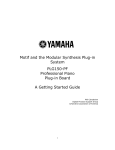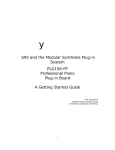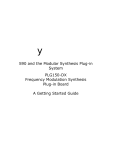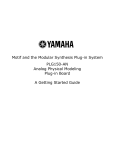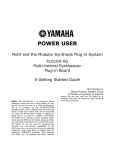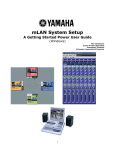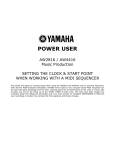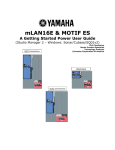Download MFC10 MIDI Foot Controller
Transcript
y POWER USER MUSIC PRODUCTION and PERFORMANCE With the Motif ES & MFC10 The MFC10 MIDI FOOT CONTROLLER The ULTIMATE UTILITY MIDI DEVICE Phil Clendeninn Technology Products ©Yamaha Corporation of America If you play “live” and need to automate anything with your Motif ES, the MFC10 is a weapon you will want to add to your arsenal. It adds functionality and “handsfree” operation to your stage rig. The MFC10 should be connected to your Motif ES as follows: Connect MIDI OUT of the MFC10 to MIDI IN of the Motif ES. The MFC10 is like a Swiss-Army™ knife MIDI device…it can do so many things. The better your understanding of MIDI the more possibilities you will dream up. Your settings will remain in memory of the MFC10 You can back up your MFC10 settings by bulking the data to the Motif ES sequencer and storing that data to SmartMedia or USB device. Keep your manual in a safe place because you will be referring to it for the various MIDI messages. To reset the MFC10: power up while holding the [MEMORY EDIT] + [FC EDIT]. This will load in a set of examples. Set the NORMAL/MIX switch on the back panel to NORMAL; Press the FUNCTION button so that the LED is lit. Each press of a Foot Switch will send out a 4-note chord to the Motif ES. Use the x10 switch to change the bank. The first four banks (F0x, F1x, F2x, and F3x) have unique chord progressions programmed to play from the switches; These utilize the ability of the MFC10 to preset 4 note chords to a switch – play these well known progression to get an idea of the chord function. Then we will learn how this is accomplished and more. Here are just a few of the possibilities… and much, much more… The MFC10 is one of those MIDI devices that it is impossible to tell you everything that it can do. You have to have a ‘MIDI-need’ and the MFC10 can probably do it for you. It is a true Power User’s utility device. If you perform live the MFC10 can add much functionality to your keyboard. In this article we will be talking about a few things that it can do for you and your Motif ES keyboard. The MFC10 was designed for users who need to change complex setups yet keep their hands free to play their instrument. This is why it is already very familiar to MIDI Guitarist (G50) and to MIDI Wind Controller (WX5) players. Keyboard players can also use the MFC10 for hands-free operation of their synth. The unit features twelve switches and a sweep pedal. In addition to this there are jacks for four optional pedals. You can plug in FC4, FC5 (momentary footswitches) or FC7 (sweep pedals) in any combination. The jack will ‘know’ what kind of pedal you have plugged in (use only genuine Yamaha foot pedals for best operation and reliable results). It is a highly sophisticated tool and can be customized so that when you are on stage you can recall any setup no matter how complex. The theory of operation is to preset the MFC10 in advance and use it to recall your setups. Programming is done ahead of time and you are provided stickers so that you can label the footswitches, as necessary. This is why we call it the Swiss-Army™ knife of MIDI controls – because it can do most anything. THEORY of OPERATION There are two main modes on the MFC10: NORMAL and MIX. You select the mode of operation by a back panel switch. What is being referred to here the main working operations… how you will setup the MFC10 to work. In what is called NORMAL mode you have 2 functions: Program Change and Function. PROGRAM CHANGE memory is where the footswitches are used to recall preset 128 Program Change messages. You are in the Program Change Memory when the FUNCTION LED is OFF. Step on the Function switch and you move to the FUNCTION memory area. Function is where the footswitches can be preset to send various commands like Section change, start/stop, etc., up to 100 Functions can be stored. The other main mode is called MIX which refers to the fact that you no longer have to use the Function LED to toggle back and forth between PC and Functions, that is, the top row of footswitches can be Function memories and the bottom row of footswitches can be Program Change memories. If you have just a few things you need the MFC10 to do the MIX mode gives you access to both on one panel. Which you use will depend on what you need to do. Programming the MFC10 is like writing in code – because you are writing in MIDI coded commands, but once you have locked in what you need it to do, a press of a footswitch recalls it all. So what can you do? Oh…for starters: • Start the sequencer • Stop the sequencer • Continue the sequencer from the last stopped position • Trigger a sample (send up to 4 Note-ons on any specific channel) • Change Chord voicing controlling an Arpeggio • Send a Bank Select / Program change • Select a Song • Select Pattern • Send Pattern Section change commands • Set up foot volume controls for multiple MIDI channels; 4-ZONE Foot Volume command • Send Aftertouch information on a specific channel from a sweep pedal • Send Pitch Bend information on a specific channel from a sweep pedal • Send Aftertouch from a sweep pedal • Set up for control of effects processors with foot controllers • Setup a wah-wah pedal • Switch portamento ON/OFF • Control pan position • Control Tempo via a sweep pedal* (see final paragraph) Program Changes Let’s begin with something basic, like setting up a simple program change sequence. There are 128 Program Change locations (001-128) on the MFC10. Each one can be preset to send a command to the Motif ES and select any Voice from any of the six Preset banks, two User banks, Preset Drum bank, User Drum bank, or PLG User banks. Here’s how it does it: when you step on the pedal assigned to location 001 you can have that location send data on a predetermined MIDI channel a bank select and program change message. Every bank in the Motif ES has a designation as to MSB/LSB bank numbers. If you are new to this here is a brief explanation. Bank Select commands give manufacturers 128 MSB numbers and 128 LSB numbers to define banks and 128 Program Changes in each bank…that is a mind boggling 16,384 possible banks, each with 128 Program Changes. A Voice in the Preset 1 bank of the Motif ES is in bank 63/0. The MSB and LSB numbers are control change messages that help locate and differentiate the Voice in Preset 1 location 001 and the Voice in Preset 2 location 001, from the Voice in Preset 3 location 001 and so on. 2 Bank Preset 1 Preset 2 Preset 3 Preset 4 Preset 5 Preset 6 User 1 User 2 Preset Drum User Drum GM GM Drums Seq. Sample Mix Voice PLG150 PLG1USR PLG2USR PLG3USR PLGPRE1 PLGPRE2 *VL PLGPRE3 *VL • MSB / LSB 63 / 0 63 / 1 63 / 2 63 / 3 63 / 4 63 / 5 63 / 8 63 / 9 63 / 32 63 / 40 0 /0 127/ 0 63 / 50 63 / 60 • • • • MSB / LSB 63 / 24 (slot 1) 63 / 25 (slot 2) 63 / 26 (slot 3 63 / 70, 73, 76 63 / 71, 74, 77 63 / 72, 75, 78 • • While in Voice mode you can press the INFORMATION button and view what Bank your current Voice is in. • • Connect MIDI OUT of the MFC10 to MIDI IN of the Motif ES Make sure that the Motif ES is set to MIDI IN/OUT = MIDI; UTILITY/ F5 MIDI/ SF4 OTHER and that the Motif is set to Basic Receive channel 1 On the MFC10 make sure the FUNCTION LED is OFF (this selects Program Change Memory) and select location 001 Press the [MEMORY EDIT] button to enter Edit mode The STATUS LED (and the 1 LED) will flash. This parameter will set the MIDI channel. Set the screen to read C0 (read: see-zero) which translates to MIDI channel 1 Press [MEMORY EDIT] to toggle to DATA/CTRL. This parameter will set the Program Change number. Set this to 115. Hold down the [INC/YES] button and tap the [DEC/NO] to advance by +10. Press [MEMORY EDIT] to toggle to BANK MSB/MAX. This parameter will set the Bank MSB number. Set this to 063. Press [MEMORY EDIT] to toggle to BANK LSB/MIN. This parameter will set the bank LSB number. Set this to 000. Press the [WRITE/EXIT] button. The Memory location number (001) will flash rapidly – consider this asking you “Are you sure?”. Press YES to lock in your setting. Bank MSB/LSB numbers are also used in the sequencer setup to select banks within a MIX setup on a per MIDI channel basis… You can review your settings by pressing the MEMORY EDIT button repeatedly to scroll through the parameters. Then you can press [WRITE/EXIT] to EXIT without making a change. Bank Select and Program Change messages are in a category of MIDI messages called Control Change events – which are MIDI channel messages. They cannot be used to select Elements within a Voice, nor can they select Voices within a Performance. This is due to the fundamental fact that Elements of a Voice and Voices within a Performance are addressed on the same MIDI channel. Now let’s set MFC10 location 002 to recall the “St:2 Violins” Voice in Pre3:001. Here’s what you need to know: Pre3 is bank 063/002 • Press MFC10 Footswitch 2 or use the [INC/YES] button to select 002 • Press [MEMORY EDIT] • STATUS = C0 (MIDI Channel) • Press [MEMORY EDIT] • DATA = 001 (Program Change) • Press [MEMORY EDIT] • MSB = 063 (Bank MSB) • Press [MEMORY EDIT] • LSB = 002 (Bank LSB) • Press [WRITE/EXIT], then YES. These are the fundamental steps in setting up a Program Change Memory, now let’s talk possibilities. Let’s say you like to work in a SONG MIX (because it lets you seamlessly move from PART to PART without interruption of notes – this is accomplished by using the Motif ES front panel TRACK SELECT buttons, as necessary, to switch PARTS. This is a real possibility now in the Motif ES for live players -- since 8 PARTS in a MIX can recall their Dual Insertion effects from Voice mode For example let’s begin by assigning Program Change Memory location 001 to select the Voice “Dave’s B” which is located in the Motif ES at “Pre1: 115” Preset bank 1 on the Motif is MSB/LSB 063/000 Prepare to program the MFC10: • Make sure that the Function Normal – Mix switch is set to Normal on the back panel 3 you can use a MIX very effectively in a live setup. You can set a Program Change Memory to transmit on any MIDI channel, therefore you can change any PART, as necessary, even while you are actually playing on a different MIDI channel. By setting the STATUS parameter setting you can address any channel of the MIX you want. Remember that the Channel count begins with 0 for channel 1 – C0 is MIDI channel 1; C1 is MIDI channel 2, C2 is MIDI channel 3 and so on. See the manual for a convenient chart. Now let’s look at the other main mode: Function. Repeat and program each SECTION to a Fxx button, as necessary. Using the “New R&B” pattern 01 from the DEMO set program Section as follows: F01 F02 F03 F04 F05 F06 F07 F08 Functions There are nine types of messages that can be sent from the Function Memory locations: Note ON/OFF, Control Change messages, Program Change, Song Select, Start, Continue, Stop, Section Control and Tempo Control. The Function Memory locations (100) will allow your imagination to run wild. They will show up in the screen listed from F00~F99. • • • • • • Section Section Section Section Section Section Section Section A C01 B C02 C C03 D C04 E C05 F C06 G C07 H C08 If you use Sections I-P continue to setup procedure as necessary following the above outline. --GETTING CREATIVE-Now let’s see some of the potential that the MFC10 has with the Motif ES. In this scenario we will set some Function switches to Start and Stop. We will also assign a four-note chord to a Function button and have it trigger a chord for the arpeggio. Function location F09 will be START Function location F00 will be STOP Function location F11 Cm7 chord Let’s begin with something basic like SECTION CONTROL - using Function memories to select the Motif ES PATTERN mode Sections A-P. • • = = = = = = = = START • Press Function switch 9 to select F09 • Press [MEMORY EDIT] • The STATUS LED will flash. Use the [INC/YES] button to select FA. This is the MIDI Start command. • Press [WRITE/EXIT], then [INC/YES] to lock in your setting. Select Pattern Mode on the Motif ES Go to UTILITY/ F3 SEQ/ SF4 OTHER. Set the Pattern Quantize to the value you want Sections to change: the next 1/16 note through to 1 (the next measure). This will control how quickly after you press the footswitch the change will be actually made. Press the FUNCTION footswitch so that the LED is lit. This selects the FUNCTION Memory area. Press MFC10 Footswitch 1 to select Function location F01 Press [MEMORY EDIT] to enter the Edit mode The STATUS LED will flash. This parameter will allow you to select the function. SECTION CONTROL is Function F0. Press [MEMORY EDIT] to toggle to DATA/CTRL. This parameter will select the SECTION. Set this to C01, which will select SECTION A on the Motif ES. Press the [WRITE/EXIT] button. The Memory location number (F01) will flash rapidly – consider this asking you “Are you sure?”. Press YES to lock in your setting. STOP • Press Function switch 0 to select F00 • Press [MEMORY EDIT] • The STATUS LED will flash. Use the [INC/YES] button to select FC. This is the MIDI Stop command. • Press [WRITE/EXIT], then [INC/YES] to lock in your setting. Press the [x10] button to advance to of Function locations. The 10’s digit flash, press the 1 switch to select 1x. will now flash, press 1 to select 11. program location F11. Select F11. the next set will start to The 1’s digit Now we will NOTE ON/OFF Up to a four-note chord can be transmitted from any Function button: step on the Footswitch and the chord is sent – let go the chord is not sent. This is perfect for the Motif ES especially since it has a four-track arpeggiator. This function can let you preset a chord voicing that will trigger the arpeggiator on any MIDI channel (even if you are playing another). Here we will make use of the “Toggle ON/OFF Program Number” parameter Now lets set MFC10 location F02 to recall SECTION B. • Press [INC/YES] to increment the display to F02 or press Footswitch 2 directly. • Press [MEMORY EDIT] • STATUS = F0 (Section Control) • Press [MEMORY EDIT] • DATA/CTRL = C02 (Section value) • Press [WRITE/EXIT], then YES. 4 • (Pn1-Pn4) function to program a Cminor7 chord. Call up the Voice: “USER 1:001 Gt:Unplugged” • • Note-on messages in MIDI are denoted by “9x”, where the “9” denotes a note-on and where “x” is the MIDI channel (0-F hex) 1-16. • Press the [MEMORY EDIT] button. The Pn1 (parameter number 1) is automatically selected although it is not shown. We will set this parameter to note ‘middle C’. • The STATUS LED will flash. Set the Status = 90 (note-on MIDI Channel 1) • Press [MEMORY EDIT] • DATA/CTRL = 60 (note 60 is middle C) • Press [MEMORY EDIT] • BANK MSB/MAX is selected. This parameter will allow us to set the Note-on Velocity. Set this to 100. • Press [MEMORY EDIT] • BANK LSB/MIN is selected. This parameter will allow us to set the Note-off Velocity. Leave this at 64 • Press [MEMORY EDIT] • Pn1 will be showing – indicating that we have finished programming Pn1. Press [INC/YES] to select Pn2. • Press [MEMORY EDIT] • STATUS = 90 • Press [MEMORY EDIT] • DATA/CTRL = 63 (note 63 is Eb above middle ‘C’) • Press [MEMORY EDIT] • BANK MSB/MAX is selected - this parameter will allow us to set the Note-on Velocity. Set this to 100. • Press [MEMORY EDIT] • BANK LSB/MIN is selected this parameter will allow us to set the Note-off Velocity. Leave this at 64 • Press [MEMORY EDIT] • Pn2 will be showing. [Press INC/YES] to select Pn3. • • • • • • • • • • • • • • Bank MSB/MAX is selected this will allow us to set the Note-on Velocity. Set this to 100. Press [MEMORY EDIT] Bank LSB/MIN is selected this will allow us to set the Note-off Velocity. Leave this at 64 Press [WRITE/EXIT]; F11 will flash, then press [INC/YES]. Now when you press and hold F11 you will send a Cminor7 chord (C3-Eb3-G3-Bb3) on MIDI channel 1 to the Motif ES. C3 = note 60 Eb3 = note 63 G3 = note 67 Bb3 = note 70 If you apply this to the “New R&B” Demo Pattern you can quickly see how you can trigger a chord to play on MIDI channel 1 and simultaneously you can be playing any other sound via the keyboard (simply use the front panel Track Select buttons to choose a different PART to trigger via the keyboard). Of course, you can program any of the Memory locations to suit your needs. Perhaps you do not need Start and Stop on foot switches and would rather place the chords in the same group with the Section changes. That is the purpose of the MFC10 being programmable, you can place the functions and controls in any locations that suit your needs – and only you will know what is useful for you. You may want to program a PATTERN CHAIN to start a composition but leave the ending open. For example, you have a PATTERN mode composition that starts the same every time, i.e., Section A, B, A, C, A, A, D etc., but when you reach the solo section (Section D) you might want to extend the arrangement. This is when you can take over, “live”, with your MFC10 Footswitch assignments. Simply do not program any Section Change events in the Chain after you reach the solo section (D). When you get to the solo section you make all changes with the MFC10. Press [MEMORY EDIT] STATUS = 90 DATA/CTRL = 67 (note 67 is G) Press [MEMORY EDIT] Bank MSB/MAX is selected this will allow us to set the Note-on Velocity. Set this to 100. Press [MEMORY EDIT] Bank LSB/MIN is selected this will allow us to set the Note-off Velocity. Leave this at 64 Press [MEMORY EDIT] Pn3 will be showing. Press [INC/YES] to select Pn4. PEDALING POSSIBILITIES: Setting up a 4-Zone / 4 Volume pedal situation There are multiple jacks on the back panel of the MFC10 which means you can plug in various Yamaha FC pedals. The jacks are assignable and can handle either the FC4/5 momentary footswitch type pedals or the FC7 sweep type pedals. You are given one sweep type pedal to get you started. Foot Controllers can transmit Control Change messages, Aftertouch messages and Pitch Bend messages. You can, for example, use the MFC10 to setup a scenario where you are transmitting on multiple zones with an independent Volume pedal for each zone. Perhaps you have a 4-zone setup in the Motif ES where you have a MASTER setup and want independent control via foot controllers. Press [MEMORY EDIT] STATUS = 90 DATA/CTRL = 70 (note 70 is Bb) Press [MEMORY EDIT] 5 Set up the Motif ES & MFC10 using three optional Yamaha FC7 foot controllers for a 4-ZONE / 4Volume pedal control setup. The goal is to have four independent voices in a multiple zone set-up (using Master Keyboard mode), each voice using a foot controller to control Volume (cc007). The problem here is that if you use a PERFORMANCE to play four PARTS simultaneously because they are on the same MIDI channel, if you change the Volume (cc007) for one of the Parts it will change the Volume for all the PARTS. After all, they are on the same MIDI channel. How come you can individually control the volumes of PARTS in a Performance with the CS? Because the CS in Performance mode use System Exclusive messages to individually control the PARTS 01-04. A Foot Controller assigned to Control Change message 007 will control all Parts on that MIDI channel simultaneously. If you need independent control via Foot pedals of four PARTS you will need to use 4 separate MIDI channels and 3 additional FC7 pedals (the MFC10 provides you with one assignable sweep pedal). Here’s how to set it up: • • MOTIF ES: SETUP THE MASTER • Press [MASTER] • Press [F2] MEMORY • On this page you can associate the MASTER Memory with the SONG MIX you just created and you can set up for ZONE operation. • Set the MODE to SONG and MEMORY to the SONG location number. • Set the ZONE SWITCH to ON • Press EDIT and set the parameters for the MASTER ZONE setup. • Press [COMMON] / F1 NAME and give your setup a name. Press F2 OTHER and select a function for your CS (pan, tone, assign, Part EQ, Master Effects, arp effects, or zone control). • Touch TRACK [1] to select ZONE parameters All three optional FC7 pedals must be plugged into the back panel of the MFC10, one FC7 into Foot Controller 2, another FC7 into Foot Controller 3, and the last one into Foot Controller 4. Foot Controller 1 is the one built into the MFC10. The MFC10 should be connected to your Motif ES. 1. 2. 3. You will want to activate all 4 Zones. Zone 1 to MIDI channel 1, Zone 2 to MIDI channel 2 and so on. Transmitting to the internal tone generator (TG). Set the TG SWITCH for each to ON. Setup a SONG MIX with your 4 Voices in Parts 1-4 Associate this SONG MIX with a 4 Zone Master Setup Setup the MFC10 with 4 pedals each assigned to control a Zone. This example will use four Voices in the Motif ES setup in four PARTS of a SONG MIX (alternatively you can use a PATTERN MIX). Then we will associate that MIX with a MASTER ZONE setup, and assign the MFC10 to each channel in turn: Set the other ZONE parameters as necessary for your particular needs, that is, Note Limits, Octave, transpose, etc. Press F2 to make these settings: MOTIF ES: SETUP THE SONG MIX Select your favorite Voices and assign them to the first four PARTS of the blank SONG MIX: MSB/LSB Voice PRE1: 001 [Ap:Full Grand] 63/0 -- #1 PRE1: 027 [Kb:ChorusHard] 63/0 -- #27 PRE3: 016 [St:Background] 63/2 -- #16 PRE2: 083 [Ba:Upright ] 63/1 -- #83 • • • • Name the SONG using the SONG/ JOB / F6. You can select the name function by returning to the Main SONG screen (press SONG), then press JOB followed by F6. Scroll down to the SONG NAME job. Store the MIX • Call up a blank Song location Press MIXING Press F2 VOICE Use the TRACK SELECT buttons to select a PART and assign your Voices to the PARTS. Store your MASTER setup. PROGRAM THE MFC10 You will be editing the Foot Controller Data (page 22 in the MFC10 Owner’s Manual) in the MFC10. You will use Control Change message 007 Volume. A Control Change message is written “bx”, where 6 “b” is Control Change and “x” is a hexadecimal value for the MIDI channel 0-F (1-16). • Assigning the on-board pedal - Footswitch 1 • Press [FC EDIT], to select Foot Control Edit. Press footswitch button, 1 to select Foot Controller 1 to be edited (the lamp above the footswitch will flash). • STATUS will be flashing. Press [INC/YES] or [DEC/NO] as necessary to select b0. The letter “b” indicates this will be a Control Change command. This will set the FC7 for the on-board FC to transmit controller information on MIDI Channel 1 (the zero indicates MIDI channel 1). • Press [FC EDIT] to set the DATA/CTRL and use [INC/YES] and [DEC/NO] to select 007. This selects the Volume, Controller #7. • Press [FC EDIT] to see Maximum Volume 127 • Press [FC EDIT] to see Minimum Volume 000 • Push the [Write/Exit] Switch, FC1 will flash in the screen and then push [INC/YES]. This has stored the information. • • • Press [FC EDIT] to set the DATA/CTRL and use [INC/YES] and [DEC/NO] to select 007. This selects the Volume, Controller #7. Press [FC EDIT] to see Maximum Volume 127 Press [FC EDIT] to see Minimum Volume 000 Push the [Write/Exit] Switch, FC3 will flash in the screen and then push [INC/YES]. This has stored the information. Assigning an FC7 - Footswitch 4 to make the assignment • Press [FC EDIT], to select Foot Control Edit. Press footswitch button, 4 to select Foot Controller 4 to be edited (the lamp above the footswitch will flash). • Press [FC EDIT] again to select STATUS. Press [INC/YES] or [DEC/NO] as necessary to select b3. The letter “b” indicates this will be a Control Change command. This will set the FC7 for the on board FC to transmit controller information on MIDI Channel 4 (the “3” indicates MIDI channel 4). • Press [FC EDIT] to set the DATA/CTRL and use [INC/YES] and [DEC/NO] to select 007. This selects the Volume, Controller #7. • Press [FC EDIT] to see Maximum Volume 127 • Press [FC EDIT] to see Minimum Volume 000 • Push the [Write/Exit] Switch, FC4 will flash in the screen and then push [INC/YES]. This has stored the information. Assigning an FC7 – use Footswitch 2 to make the assignment • Press [FC EDIT], to select Foot Control Edit. Press footswitch button, 2 to select Foot Controller 2 to be edited (the lamp above the footswitch will flash). • Press [FC EDIT] again to select STATUS. Press [INC/YES] or [DEC/NO] as necessary to select b1. The letter “b” indicates this will be a Control Change command. This will set the FC7 for the on board FC to transmit controller information on MIDI Channel 1 (the “1” indicates MIDI channel 2). • Press [FC EDIT] to set the DATA/CTRL and use [INC/YES] and [DEC/NO] to select 007. This selects the Volume, Controller #7. • Press [FC EDIT] to see Maximum Volume 127 • Press [FC EDIT] to see Minimum Volume 000 • Push the [Write/Exit] Switch, FC2 will flash in the screen and then push [INC/YES]. This has stored the information. Now each Pedal will control a separate MIDI channel of your MIX 1-4. Assigning Pitch Control to a Foot Controller Bending Up (toe down = pitch up) • Press the [FC EDIT] button • Press Footswitch 1 to set the on-board FC • STATUS = E0 Pitch Bend on MIDI channel 1 • Press [FC EDIT] • DATA/CTRL = --• Press [FC EDIT] • Set Maximum to 127 • Press [FC EDIT] • Set Minimum to 64 • Push the [Write/Exit], then [INC/YES] Bending Down (heel down = pitch down) • Press the [FC EDIT] button • Press Footswitch 1 to set the on-board FC • STATUS = E0 Pitch Bend on MIDI channel 1 • Press [FC EDIT] • DATA/CTRL = --• Press [FC EDIT] • Set Maximum to 64 • Press [FC EDIT] • Set Minimum to 0 • Push the [Write/Exit], then [INC/YES] Assigning an FC7 - Footswitch 3 to make the assignment • Press [FC EDIT], to select Foot Control Edit. Press footswitch button, 3 to select Foot Controller 3 to be edited (the lamp above the footswitch will flash). • Press [FC EDIT] again to select STATUS. Press [INC/YES] or [DEC/NO] as necessary to select b2. The letter “b” indicates this will be a Control Change command. This will set the FC7 for the on board FC to transmit controller information on MIDI Channel 3 (the “2” indicates MIDI channel 3). Assigning Aftertouch to a Foot Controller • Press the [FC EDIT] button • Press Footswitch 1 to set the on-board FC 7 • • • • • • • • STATUS = d0 Aftertouch MIDI channel 1 Press [FC EDIT] DATA/CTRL = --Press [FC EDIT] Set Maximum to 127 Press [FC EDIT] Set Minimum to 0 Push the [Write/Exit], then [INC/YES] *Assigning Tempo to a Foot Controller (Motif ES) In order to control Tempo via the MFC10 we will need to use the Assignable A or Assignable B device within the Motif ES. • Press UTILITY • Press F4 CTL ASN • Press SF2 ASSIGN • Set the AS A device to a Destination of TEMPO. This will mean when cc018 is being used the Motif ES will change Tempo. If you want to assign the on-board sweep pedal to control tempo: • Press the [FC EDIT] button • Press Footswitch 1 to set the on-board FC • STATUS = b0 Control Change MIDI channel 1 • Press [FC EDIT] • DATA/CTRL = 018 • Press [FC EDIT] • Set MAX Tempo range 127=300bpm • Press [FC EDIT] • Set MIN Tempo range 0=001bpm *Experiment to find the Minimum and Maximum range settings that work for your song/pattern. It will not be an exact science – there are a potential 2,990 possible tempos between 001.0 bpm and 300.0 bpm and there are only 128 steps between 0 and 127. You will discover that resolution is weighted to lower tempos. We have only begun to scratch the surface of what is possible – but this should give you an idea of the potential and the method of programming what you need. Happy pedaling… Phil Clendeninn Technology Products ©Yamaha Corporation of America 8








